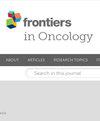累及胃肠道和消化器官的弥漫大B细胞淋巴瘤患者的疗效和毒性反应
IF 3.5
3区 医学
Q2 ONCOLOGY
引用次数: 0
摘要
背景累及胃肠道(GI)器官的弥漫大 B 细胞淋巴瘤(DLBCL)非常罕见,采用全身治疗(ST)和放疗(RT)联合模式治疗(CMT)后的实际疗效并不理想,尤其是在当代。我们研究了一大批单独接受 ST 或 CMT 治疗的消化道-DLBCL 患者的预后。Kaplan-Meier和Cox回归模型估计了生存率。结果 在204名患者中,胃部受累最为常见(63%)。大多数患者为早期疾病(61%)。所有患者都接受了ST治疗,65名患者(32%)接受了RT治疗,其中88%是一线CMT治疗的一部分。中位剂量为 36 Gy(IQR 30.6-39.6),分 18 次进行(IQR 17-22)。中位随访时间为 46 个月。五年总生存率(OS)和无进展生存率(PFS)分别为88%和84%;完全缓解率(CR)为82%。OS的改善与低IPI(p=0.001)、化疗次数少(p<0.001)、早期分期(p<0.006)和CR(p<0.001)有关。接受 RT 治疗后的生存率没有差异(p>0.25)。在多变量分析中,只有早期分期和CR与OS的改善相关。胃定向 RT 与其他部位 RT 相比,PFS 和 OS 均有改善(p<0.04)。在后利妥昔单抗时代接受CMT治疗的早期DLBCL患者的OS与单纯ST治疗相当,即使化疗周期较少(p<0.02;接受RT治疗的中位数为4个周期,未接受RT治疗的中位数为6个周期)。50例患者的病变体积较大(≥7.5厘米),其中18例(36%)为早期病变。在肿瘤体积较大的患者中,有5人(10%)在最初的发病部位复发。在这5名患者中,有4名没有接受巩固性放射治疗。在这 4 位患者中,有 3 位仅在最初的大块病变部位复发。在191例腔内消化道-DLBCL患者中,有4例(2.1%)出现穿孔;其中只有1例接受了RT治疗。41.2%的患者出现急性3级毒性反应,12例(5.8%)患者出现晚期3级毒性反应,99%归因于化疗。CMT可与简化的全身治疗方案一起使用,且疗效相当。胃引导-RT可减轻与疾病反应不完全或大块疾病相关的复发风险。本文章由计算机程序翻译,如有差异,请以英文原文为准。
Outcomes and toxicities in patients with diffuse-large B cell lymphoma involving the gastrointestinal tract and digestive organs
BackgroundDiffuse large B-cell lymphoma (DLBCL) involving the gastrointestinal (GI) organs is rare, and real-world outcomes after combined modality therapy (CMT) with systemic therapy (ST) and radiotherapy (RT) are not well-characterized, particularly in the contemporary era. We characterized outcomes in a large cohort of GI-DLBCL patients treated with ST alone or CMT.MethodsPatients with GI-DLBCL treated at a single institution were retrospectively reviewed. Kaplan-Meier and Cox regression models estimated survival. Multivariable analyses were conducted using the Cox proportional hazards model.ResultsOf 204 patients, gastric involvement was most common (63%). Most presented with early-stage disease (61%). All patients received ST and 65 patients (32%) received RT, 88% as part of first-line CMT. Median dose was 36 Gy (IQR 30.6–39.6) in 18 fractions (IQR 17–22). Median follow-up was 46 months. Five-year overall survival (OS) and progression-free survival (PFS) was 88% and 84%, respectively; complete response (CR) rate was 82%. Improved OS associated with low IPI (p =0.001), fewer chemotherapy lines (p <0.001), early stage (p <0.006), and CR (p <0.001). Survival did not differ by RT receipt (p >0.25). Only early stage and CR correlated with improved OS on multivariable analysis. Stomach-directed RT vs. RT to other sites correlated with improved PFS and OS (p <0.04). Patients with early stage DLBCL treated with CMT in the post-rituximab era had equivalent OS vs. ST alone, even with fewer chemotherapy cycles (p <0.02; median of 4 with RT vs. 6 cycles without). Fifty patients had bulky disease (≥7.5 cm), of whom 18 (36%) had early stage disease. Among patients with bulky disease, 5 (10%) developed relapse at the initial site of disease bulk. Four of the 5 patients did not receive consolidative radiation. Among these 4 patients, 3 relapsed only in their initial site of bulky disease. Of 191 patients with luminal GI-DLBCL, n =4 (2.1%) developed perforation; only one received RT. Acute Grade 3 toxicities were reported in 41.2% of patients, and 12 (5.8%) patients had late Grade 3 toxicities, 99% attributed to chemotherapy.ConclusionGI-DLBCL patients have favorable outcomes after CMT with minimal late toxicity. CMT may be offered with abridged systemic regimens with equivalent outcomes. Stomach directed-RT may mitigate relapse risk associated with incomplete disease response or bulky disease.
求助全文
通过发布文献求助,成功后即可免费获取论文全文。
去求助
来源期刊

Frontiers in Oncology
Biochemistry, Genetics and Molecular Biology-Cancer Research
CiteScore
6.20
自引率
10.60%
发文量
6641
审稿时长
14 weeks
期刊介绍:
Cancer Imaging and Diagnosis is dedicated to the publication of results from clinical and research studies applied to cancer diagnosis and treatment. The section aims to publish studies from the entire field of cancer imaging: results from routine use of clinical imaging in both radiology and nuclear medicine, results from clinical trials, experimental molecular imaging in humans and small animals, research on new contrast agents in CT, MRI, ultrasound, publication of new technical applications and processing algorithms to improve the standardization of quantitative imaging and image guided interventions for the diagnosis and treatment of cancer.
 求助内容:
求助内容: 应助结果提醒方式:
应助结果提醒方式:


